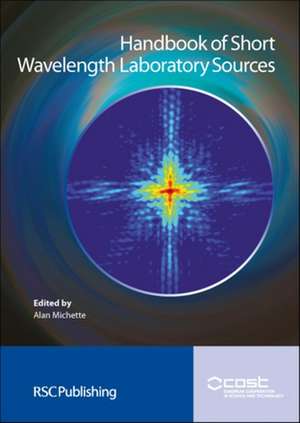Short Wavelength Laboratory Sources: Principles and Practices
Editat de Alan Michette, Davide Bleiner, John Costelloen Limba Engleză Hardback – 14 dec 2014
Our ability to manipulate short wavelength radiation (0.01-100nm, equivalent to 120keV-12eV) has increased significantly over the last three decades. This has lead to major advances in applications in a wide range of disciplines such as: the life and medical sciences, including cancer-related studies; environmental science, including studies of pollution and its effects; archaeology and other cultural heritage disciplines; and materials science. Although expansion in application areas is due largely to modern synchrotron sources, many applications will not become widespread, and therefore routinely available as analytical tools, if they are confined to synchrotrons. This is because synchrotrons require enormous capital and infrastructure costs and are often, of necessity, national or international facilities. This seriously limits their scope for applications in research and analysis, in both academia and industry. How many universities, research institutes or even industrial laboratories would have electron microscopes if electron sources cost £100M or more Hence the need to develop bright but small and (relatively) cheap x-ray sources, not to replace synchrotrons but to complement them. Written by a distinguished team of international authors this exemplary new handbook is based on the COST Action MP0601: Short Wavelength Laboratory Sources. The contents are divided into five main sections. The introductory section provides a comprehensive introduction to the fundamentals of radiation, generation mechanisms and short wavelength laboratory sources. The middle sections focus on modelling and simulation, source development: improvement and characterisation and integrated systems: sources, optics and detectors. The final section looks at recent applications.
Preț: 871.61 lei
Preț vechi: 957.81 lei
-9% Nou
Puncte Express: 1307
Preț estimativ în valută:
166.78€ • 181.73$ • 140.54£
166.78€ • 181.73$ • 140.54£
Carte indisponibilă temporar
Doresc să fiu notificat când acest titlu va fi disponibil:
Se trimite...
Preluare comenzi: 021 569.72.76
Specificații
ISBN-13: 9781849734561
ISBN-10: 1849734569
Pagini: 467
Dimensiuni: 183 x 254 x 30 mm
Greutate: 1 kg
Editura: Royal Society Of Chemistry
ISBN-10: 1849734569
Pagini: 467
Dimensiuni: 183 x 254 x 30 mm
Greutate: 1 kg
Editura: Royal Society Of Chemistry
Cuprins
Preface; Section 1: Introduction; Section 2: Modelling & Simulation; Section 3: Source Development, Improvement and Characterisation; Section 4: Integrated Systems: Sources, Optics and Detectors; Section 5: Applications; Index
Notă biografică
Professor Alan Michette did his PhD in Particle Physics at University College London. After a postdoctoral appointment at UCL he spent four years at the Rutherford Appleton Laboratory before joining Queen Elizabeth College, London as a lecturer, at which point he changed to his current research field of X-Ray Physics. Following the merger of the colleges he moved to King's College London, where he has been ever since apart from a sabbatical in Germany as an Alexander von Humboldt Fellow. In addition to his main research interests, he is the UK instigator of a project to place cosmic ray detectors in local schools with the aim of allowing pupils and teachers the opportunity to be involved in real research - science by application.
Textul de pe ultima copertă
Our ability to manipulate short wavelength radiation (0.01-100nm, equivalent to 120keV-12eV) has increased significantly over the last three decades. This has lead to major advances in applications in a wide range of disciplines such as: the life and medical sciences, including cancer-related studies; environmental science, including studies of pollution and its effects; archaeology and other cultural heritage disciplines; and materials science. Although expansion in application areas is due largely to modern synchrotron sources, many applications will not become widespread, and therefore routinely available as analytical tools, if they are confined to synchrotrons. This is because synchrotrons require enormous capital and infrastructure costs and are often, of necessity, national or international facilities. This seriously limits their scope for applications in research and analysis, in both academia and industry. How many universities, research institutes or even industrial laboratories would have electron microscopes if electron sources cost £100M or more Hence the need to develop bright but small and (relatively) cheap x-ray sources, not to replace synchrotrons but to complement them. Written by a distinguished team of international authors this exemplary new handbook is based on the COST Action MP0601: Short Wavelength Laboratory Sources. The contents are divided into five main sections. The introductory section provides a comprehensive introduction to the fundamentals of radiation, generation mechanisms and short wavelength laboratory sources. The middle sections focus on modelling and simulation, source development: improvement and characterisation and integrated systems: sources, optics and detectors. The final section looks at recent applications.
Descriere
Written by a distinguished team of international authors this exemplary new handbook is based on the COST Action MP0601: Short Wavelength Laboratory Sources.
